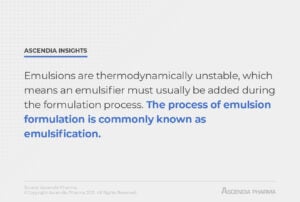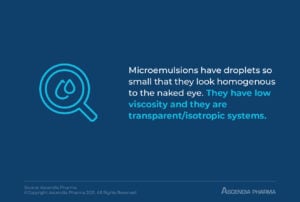Understanding Emulsion Formulation
During the formulation stage of drug development, emulsions are frequently used to deliver an active pharmaceutical ingredient. Although emulsion formulation is not used for every pharmaceutical product, it’s a common method for medications that are formulated for oral, ocular, topical mucosal, intramuscular, and intravenous use.
What Is a Pharmaceutical Emulsion?
An emulsion formulation is a liquid disperse system that uses small globules of a liquid (dispersed phase) distributed through another liquid in which it is immiscible. The dispersed phase is referred to as an internal or discontinuous phase, while the dispersion medium is the external or continuous phase.

Emulsions are used in a number of different industries, including food manufacturing, but in pharmaceuticals, an emulsion is always one of the following:
- – The active pharmaceutical ingredient (API)
- – An ingredient that enhances activity for a co-administered API, either acting passively as a solvent or stabilizing system or actively as a penetration or absorption enhancing system
- – An excipient that provides a better vehicle for API formulation
Dispersed phase globules can have a range of sizes, with the most common being from 0.1 to 10 μm in diameter; globules can be as small as 0.01 μm in diameter or as large as 100 μm. By definition, emulsions are thermodynamically unstable, which means an emulsifier must usually be added during the formulation process. The process of emulsion formulation is commonly known as emulsification.
Emulsified formulations are used for drugs, nutrients, and diagnostic agents.
Types of Emulsions
Emulsions have polar and nonpolar liquid phases. The polar phase is aqueous, while the non-polar phase consists of oil. There are two basic types of emulsions, then in addition to those, there are double or multiple emulsions.
Oil-in-Water (O/W) Emulsion
These emulsions disperse oil droplets as globules throughout a water-based (aqueous) continuous phase. Oil-in-water emulsions are used with hydrophilic emulsifiers like sodium lauryl sulfate, sodium oleate, triethanolamine stearate, and glyceryl monostearate and when the aqueous phase constitutes more than 45% of the total weight. The continuous phase contains the emulsifier, which helps stabilize the globules in the dispersed phase.
When an API is a fat or oil (or when a fat or oil must be used as a vehicle for an oil-soluble drug) and it must be delivered in an oral formulation, oil-in-water emulsions are used. For external use, oil-in-water emulsions are often chosen because they are non-greasy, can be washed off of the skin, and have a cooling effect. In addition, water-soluble drugs release the API more quickly in an oil-in-water emulsion.
Water-in-Oil (W/O) Emulsion
Water-in-oil emulsions are the opposite of oil-in-water emulsions; the aqueous phase is dispersed as globules, while the continuous, external phase is oil. These emulsions rely upon a lipophilic emulsifier for stability—the most common emulsifiers are cholesterol, sorbitan esters, calcium palmitate, and wool fats. Unlike oil-in-water emulsions, water-in-oil emulsions are mostly used for external application.
Multiple Emulsions
Multiple, or double, emulsions are a more complex type of pharmaceutical emulsion. They can be water-in-oil-in-water emulsions, or oil-in-water-in-oil emulsions.
A water-in-oil emulsion can be emulsified with water-soluble surfactants that stabilize an oil-based dispersed phase; this produces a water-in-oil-in-water emulsion with a lower viscosity than the initial water-in-oil emulsion and an external aqueous phase. In contrast, an oil-in-water-in-oil emulsion is made up of small oil droplets dispersed in water globules in a water-in-oil emulsion.
The most common applications for oil-in-water-in-oil emulsions and water-in-oil-in-water emulsions are for sustained- or delayed-action drug delivery and encapsulating proteins and hydrophilic APIs.
Microemulsions
Along with categorizing emulsions by their dispersed and continuous phases, emulsions can also be categorized by the size of the droplets they contain. Microemulsions have droplets so small that they look homogenous to the naked eye. They have low viscosity and they are transparent/isotropic systems. Microemulsions can be oil-in-water or water-in-oil, depending on the surfactants used for emulsification.

Microemulsions have droplets ranging from 5 to 140 nm in diameter; these droplets are dispersed through another liquid by the addition of a high concentration of cosolvents and surfactants.
An advantage of microemulsions is that they are thermodynamically stable for a longer period of time than a standard emulsion. We often use microemulsions at Ascendia for difficult formulations, as they can increase the bioavailability of drugs that have poor water solubility.
Microemulsions can be further broken down into the following subcategories:
- – Microemulsions (droplets between 100-600 nm in diameter)
- – Nanoemulsions (droplets below 100 nm in diameter)
Macroemulsions is the term used to describe an emulsion with droplets larger than 10 mm, while miniemulsions have droplets between 0.1–10 µm in diameter.
Delivery Method and Applications
Emulsions can also be categorized by how they are administered. There are oral emulsions, external emulsions, parenteral emulsions, and rectal emulsions.
Oral emulsions are often used to mask the taste and/or texture of a drug or oil. Oil-in-water emulsions are used for oil-soluble vitamins, high-fat preparations used for enteral feeding, and laxatives made with mineral oil, among others.
External emulsions are applied topically, often for dermatological conditions. The viscosity and feel of a product can be manipulated during formulation; for example, an emulsion being used to deliver an API for eczema may be a water-in-oil emulsion for an added emollient benefit.
Emulsion Stabilization: A Formulation Challenge
As mentioned briefly above, stability is one of the primary challenges in formulating emulsions. Like all drugs, emulsions must be stable during shipping and storage, as a drug that has degraded may not be effective, and may even be harmful. Emulsions are thermodynamically unstable on their own, as the oil and aqueous phases are prone to separation. This is why emulsifiers or stabilizers must be added to ensure shelf-life stability.
Emulsions may have the following forms of instability:
Physical
Physical stability of an emulsion refers to its physical properties—its overall appearance, including color and opacity, along with its smell, taste, and viscosity. When an emulsion is physically unstable, it may experience breaking, creaming, coalescence, or flocculation.
Chemical
Assuming a pharmaceutical drug is stored and packaged as directed and used within its shelf life, it should be chemically stable and meet both minimum potency requirements and fall below maximum allowable levels of impurities. The pharmacokinetics of a drug can be affected by the reactivity of functional groups, as with any type of formulation that relies upon a solution.
Microbial Load
Microbial load must be carefully regulated, particularly in drugs that do not undergo terminal sterilization. Good practices for aseptic manufacturing greatly reduce the possibility of contamination, but errors can create the potential for microbes to multiply. When microorganisms are present in an emulsion, it creates health risks for patients and it may also cause the aqueous and oily phases to separate.
Preservatives are added during the formulation process to help emulsions have better resistance to microbial growth. Microorganisms are typically concentrated in the aqueous phase, thus the preservative should also be added to this phase. The most common preservatives used in emulsions are butylparaben, propylparaben, and methylparaben.
Manufacturing Pharmaceutical Emulsions
When an injectable or ophthalmic emulsion is ready for scaled-up aseptic manufacturing, a mechanical method is used to blend the API and other ingredients. To guarantee uniform pharmacokinetics, manufacturing an emulsion means controlling the uniformity of surface coverage, forming the smallest droplet sizes possible, and obtaining monodisperse droplet sizes in the population.
Nanoemulsions at Ascendia Pharma
At Ascendia, we’re proud to be on the cutting-edge of nanoemulsion technology, offering our clients an advanced drug delivery system for active pharmaceutical ingredients that are poorly soluble or that have low bioavailability. Nanoemulsions can be used as substitutes for liposomes and vesicles; they can be used in a variety of formulations; they mask taste; and, most notably, they have improved physical stability over other types of emulsions. For parenteral formulations, nanoemulsions can reduce injection pain and thrombophlebitis.

Our researchers have extensive formulation experience with nanoemulsions, which means we can assist pharmaceutical companies in deciding whether oil-in-water or water-in-oil formulations are best for their drugs. Making a decision early on in the formulation process improves time-to-market and the odds of success in later stages of clinical trials.
Ascendia’s team of scientists has developed a proprietary technology called EmulSol for producing novel oil-in-water nanoemulsions using a tailored formulation approach. This technology allows us to produce stable, optically clear nanoemulsions without using organic solvents and with a lower level of surfactants than other types of nanoemulsions by using a high-pressure or microfluidic homogenization process.
Our robust, commercial-scale homogenization process uses a proprietary combination of lipid carrier and surfactants for our EmulSol formulations. The oil-in-water emulsions made with EmulSol technology are physically stable and safer for intravenous administration; eliminating solvents means less irritation at the injection site, making these drugs more acceptable for ocular, IV, and pediatric use.
If you’re faced with questions about drug delivery, emulsion formulation, or other formulations for poorly soluble and low bioavailability drugs, our team at Ascendia is up to the challenge. We have the knowledge, technology, and experience to help you overcome obstacles with your API so your drug can reach patients sooner.
Learn More About Emulsion Formulation
Contact us today to discuss your emulsion formulation needs.


